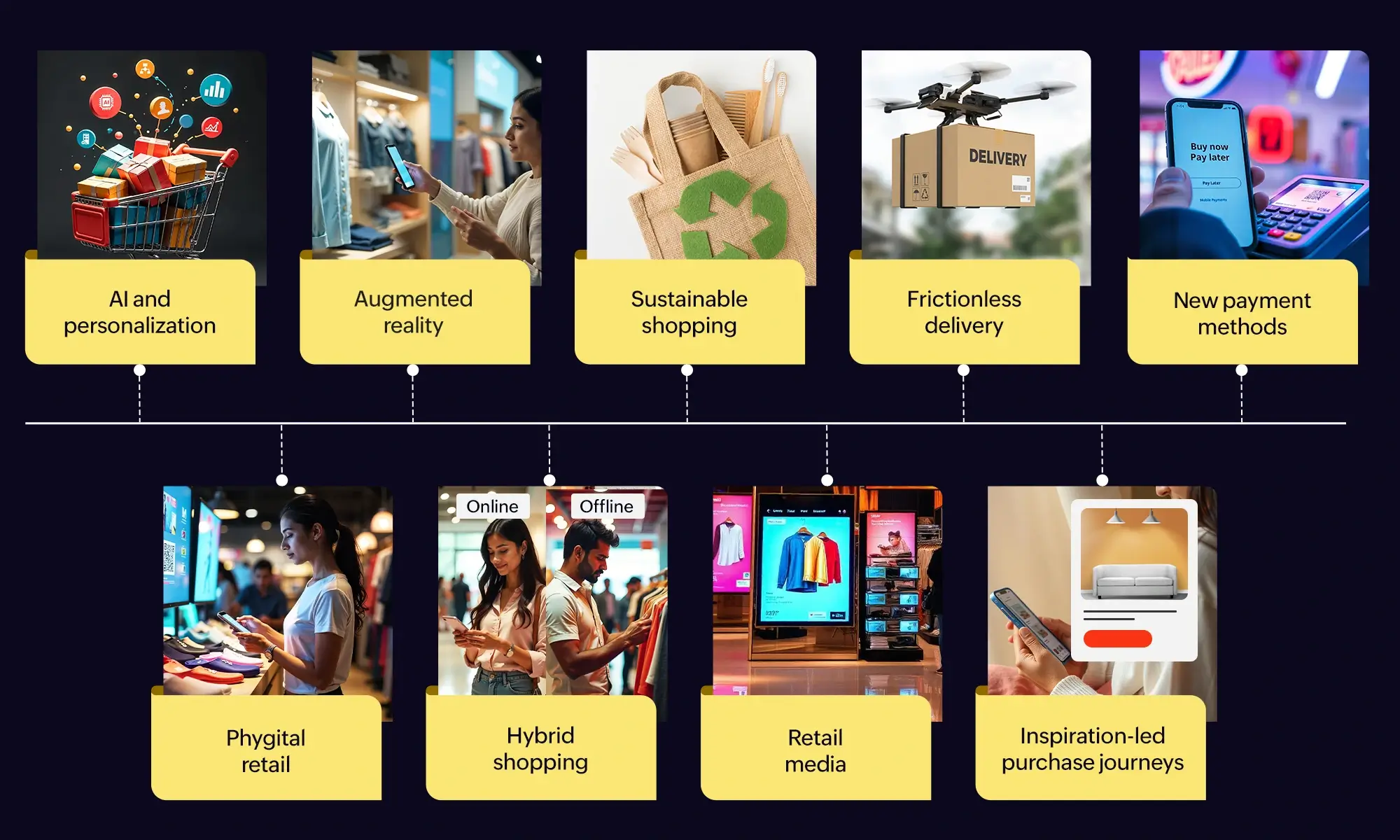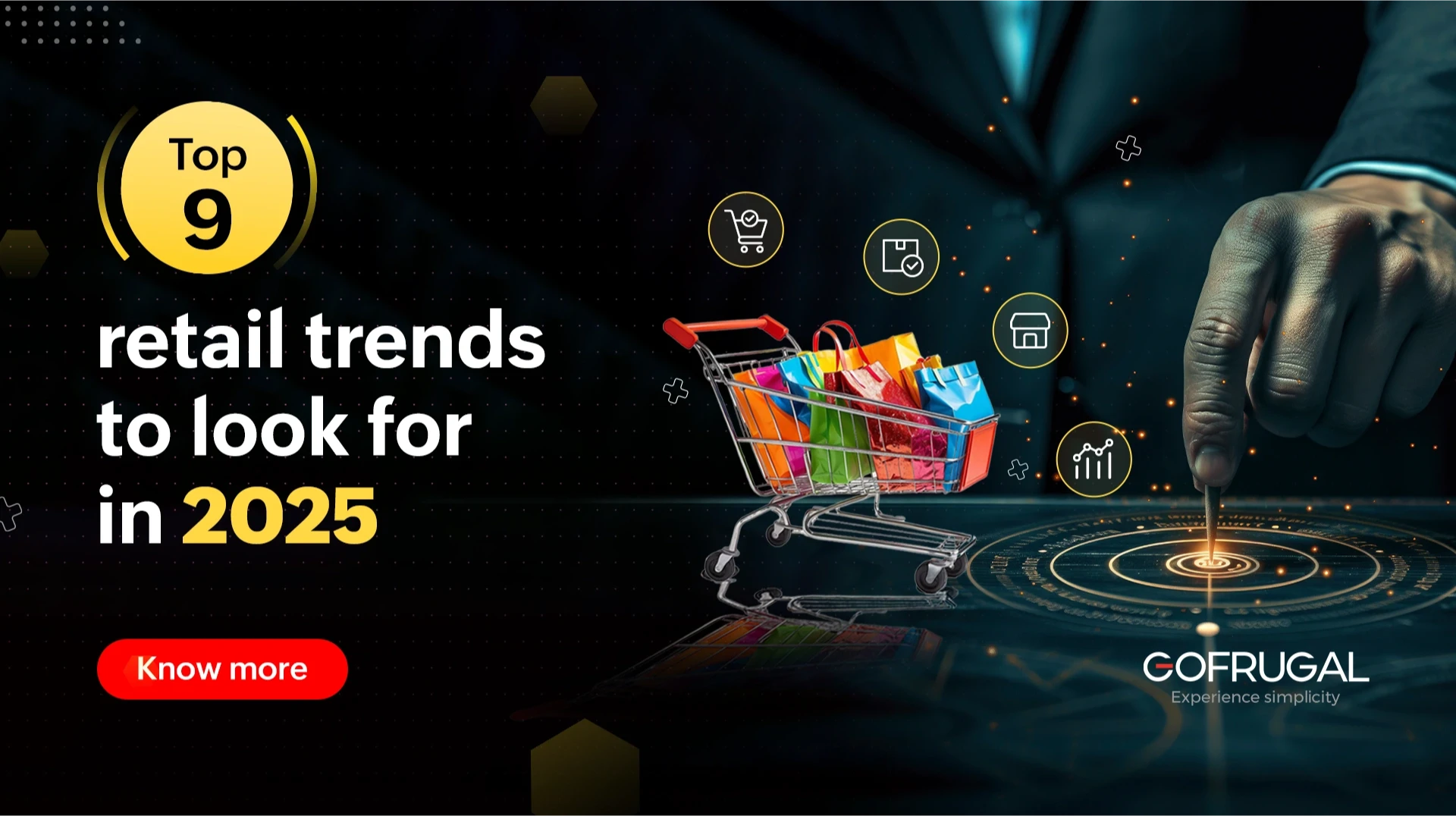The retail industry is on a transformative journey with global sales expected to reach $30 trillion by 2030, growing at a compound annual growth rate (CAGR) of 4.5%. As consumer behavior evolves and digital disruption accelerates, embracing key retail trends is no longer optional—it's essential for staying ahead. From omnichannel strategies to AI-driven insights, these trends are shaping the future of retail, helping businesses unlock growth and thrive in an increasingly competitive landscape.
9 retail trends and predictions for 2025 in India
- AI and personalization
- Augmented reality (AR)
- Sustainable shopping
- Frictionless delivery
- New payment methods
- Phygital retail
- Hybrid shopping
- Retail media
- Inspiration-led purchase journeys

1. AI and personalization
AI enables retailers to offer hyper-personalized shopping experiences, tailoring recommendations, pricing, and promotions to individual customers. By analyzing customer behavior, purchase history, and even real-time activity, AI can predict demand and prevent stockouts. Chatbots and virtual assistants powered by AI further enhance customer service, addressing inquiries instantly and improving overall satisfaction. Retailers are also using AI for dynamic pricing, ensuring competitiveness while maximizing profits.
2. Augmented reality (AR)
AR enhances customer engagement by allowing virtual interaction with products. For instance, customers can visualize furniture in their homes, try on clothing or makeup virtually, or see how a pair of glasses fits their face, all without stepping into a store. Retailers with physical stores leverage AR to create immersive experiences, such as interactive product displays, to differentiate themselves from online-only competitors. This technology also reduces returns by enabling more informed purchasing decisions.
3. Sustainable shopping
Sustainability is no longer optional as consumers increasingly prioritize eco-friendly brands. Retailers are focusing on biodegradable packaging, transparent sourcing, and carbon-neutral logistics. Circular economy models, such as recycling programs and repair services, are becoming popular. Businesses that fail to adopt sustainable practices risk losing customer loyalty and facing regulatory penalties in regions with strict environmental laws.
4. Frictionless delivery
The demand for seamless delivery experiences has reshaped logistics. Features like same-day delivery, curbside pickup, and locker pickups are becoming standard. Real-time tracking and notifications ensure customers are informed at every step of their delivery journey. Retailers are also exploring drone and autonomous vehicle delivery to cut costs and speed up fulfillment.
Implement delivery management tools to help streamline logistics, integrate with delivery partners, and optimize last-mile operations, ensuring timely deliveries and customer satisfaction.
5. New payment methods
The evolution of payment systems is revolutionizing checkout experiences. Mobile wallets like Apple Pay, Google Pay, and Paytm enable quick and contactless payments, while Buy Now, Pay Later (BNPL) services like Klarna and Afterpay offer financial flexibility. Cryptocurrency, though still niche, is gaining traction among tech-savvy consumers. Meanwhile, central bank digital currencies (CBDCs) promise secure, government-backed digital payments, signaling a shift in the financial ecosystem.
6. Phygital retail
Phygital retail combines physical and digital experiences to create a cohesive journey for customers. This includes features like QR-code-enabled product details, click-and-collect services, and smart stores where customers can shop without checkout lines. By blending the tactile benefits of in-store shopping with the convenience of digital tools, phygital retail caters to modern consumer expectations.
A software solution such as Gofrugal’s ERP and POS systems unify inventory and customer data, ensuring consistent shopping experiences across physical and digital channels.
7. Hybrid shopping
Hybrid shopping integrates the best aspects of online and in-store retail. Customers can browse and compare products online, then visit a store to touch, try, or pick them up. Innovations like virtual queues, in-store mobile checkout, and virtual consultations enhance this experience. Hybrid shopping is particularly effective in blending the immediacy of physical shopping with the convenience of digital tools.
The use of omnichannel solutions enable real-time synchronization of orders, inventory, and returns, making hybrid shopping a hassle-free experience for both retailers and customers.
8. Retail media
Retailers are monetizing their platforms by becoming media hubs. By leveraging their customer data, they offer brands ad space for targeted marketing campaigns. Retail media includes sponsored product placements, onsite display ads, and custom brand content, providing retailers with an additional revenue stream while offering advertisers unparalleled precision in targeting. Using advanced analytics tools help retailers gain insights into customer behavior, enabling them to provide advertisers with precise targeting options.
9. Inspiration-led purchase journeys
Inspiration-led shopping is fueled by platforms like Instagram, Pinterest, and TikTok, where visual content and storytelling drive purchasing decisions. Customers often encounter products through curated content, influencer posts, or aspirational narratives before feeling the need to buy. Retailers that master visual merchandising and storytelling can capture this impulse-driven demographic, turning browsing into buying.
One of the most crucial retail industry trends to embrace today is adopting or evaluating the right digital technology to grow your business. With the retail industry in India poised for unprecedented growth in 2025, staying ahead requires more than just awareness of retail trends; it demands action. To navigate this dynamic landscape, retailers must leverage data analytics, implement omnichannel strategies, and prioritize robust cybersecurity measures. By aligning with the latest retail trends in India and forming strategic partnerships with digital technology providers, stakeholders can build resilience and maintain relevance.
Curious about how to optimize your business for the evolving retail industry outlook? Talk to us today!

